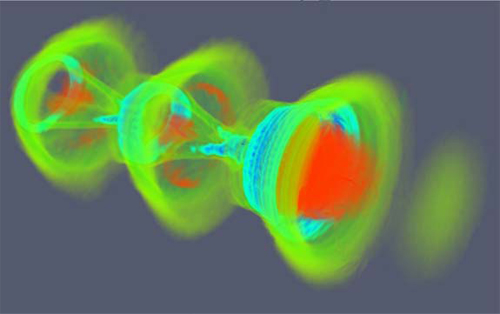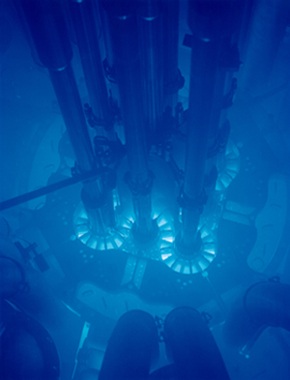Laser-Plasma Creates Electro-Optic Shocks

Image credit: PRL Cover Images ©2008 American Physical Society
Shock waves are produced when a powerful laser pulse is fired into a charged gas called plasma. This 3D image is a simulation of the shock wave produced by the interaction between the laser and the electron sheath surrounding the plasma bubble (also known as the electron cavitation region).
 The light blue circular area (furthest to the right) is the electron sheath that emits what laser physicists call electro-optic shock. Electro-optic shock is an explosion of energetic electrons traveling faster than light is able to in a gas or liquid. This creates a “sonic boom” of light which glows an “electric” blue. This phenomenon often occurs in nuclear reactors in which the reactor core creates a similar blue glow. The electron sheath is surrounds the resulting plasma bubble (red). The longer the laser pulses, the larger the bubble grows.
The light blue circular area (furthest to the right) is the electron sheath that emits what laser physicists call electro-optic shock. Electro-optic shock is an explosion of energetic electrons traveling faster than light is able to in a gas or liquid. This creates a “sonic boom” of light which glows an “electric” blue. This phenomenon often occurs in nuclear reactors in which the reactor core creates a similar blue glow. The electron sheath is surrounds the resulting plasma bubble (red). The longer the laser pulses, the larger the bubble grows.
"Electro-Optic Shocks from Ultraintense Laser-Plasma Interactions," Phys. Rev. Lett. 101, 045004 (2008)
This research was published in Physical Review Letters, July 25, 2008, was supported by the Department of Energy and Office of Naval Research, and was performed by:
| D. F. Gordon A. Ting Plasma Physics Division Naval Research Laboratory Washington, D.C. |
B. Hafizi D. Kaganovich Icarus Research, Inc. Bethesda, MD |











